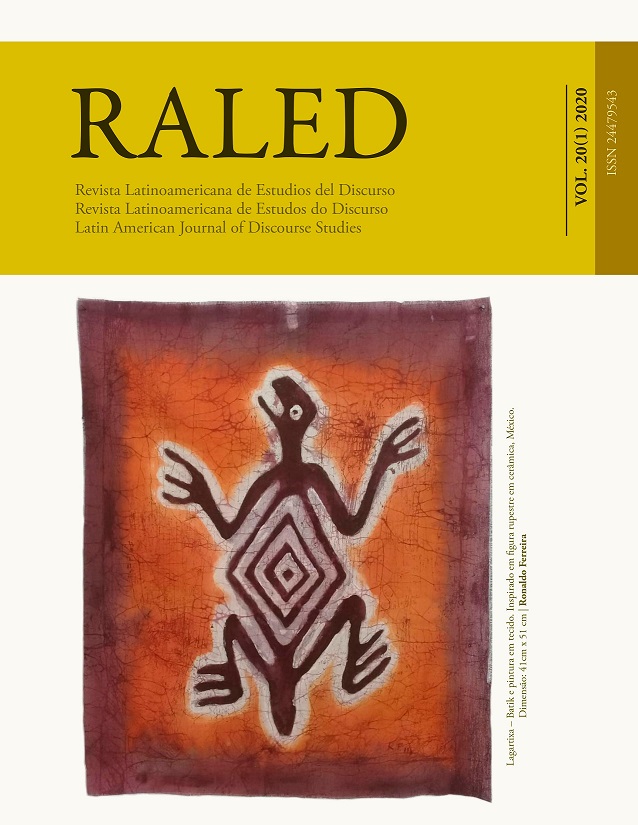The hypervisibility of the migrant body-image:
an aesthetics of nomadism in social invisibility
DOI:
https://doi.org/10.35956/v.20.n1.2020.p.25-43Keywords:
body-image. (hyper)visibility. discourse. media. refugees.Abstract
This essay discusses, through the bias of Brazilian discourse studies, crossed by the views of psychoanalysis and philosophy, the functioning of hypervisibility in the media field, understanding that it conceals the process of social invisibility of which migrant subjects are part. This work analyzes three visual/discursive regularities that emerge when the keywords “migrations”, “migrants” and “refugees” are searched, in Portuguese and Spanish, in the online search tools. These regularities Body-image, (Hyper)Visibility, Discourse, Media, Refugees. are grouped and discussed based on the notions of scopic field and visual memory. In the scopic dimension, which calls to/the gaze, the symbolic distribution of places and the construction of an aesthetics of nomadism are problematized. The reading of images as traces of a discursive/collective memory allows one to question the mediatized construction of this memory, linked to an effect of homogenization of migrations.
Downloads
References
Agier, M. 2017. Définir les réfugiés ? La demande d’asile en mots et en situation. Entretien avec Anne-Virginie Madeira. Em M. Agier y A.-V. Madeira (eds.). Définir les réfugiés. pp. 09-27. Paris: PUF.
Courtine, J.-J. 2013. Decifrar o corpo: pensar com Foucault. Petrópolis: Vozes.
Courtine, J.-J. e Marandin, J.-M. 2016. Que objeto para a análise de discurso?. Em B. Conein et. al. (eds.). Materialidades discursivas, pp. 33-54. Campinas: Editora da UNICAMP. Da Rosa, M. T. 2016. [Disponível online em: http://www.seer.ufu.br/index.php/letraseletras/article/view/33644]. Imagens não só ilustram, palavras não só descrevem: leitura e efeitos de sentido na tessitura verbo-imagética. Letras & Letras 32, 3: 45-67 [Consulta: 30 de agosto de 2019].
Dias, C. 2018. Análise do discurso digital: sujeito, espaço, memória e arquivo. Campinas: Pontes.
Didi-Huberman, G. 2010. O que vemos, o que nos olha. São Paulo: Editora 34.
Ferragut, G. 2018. Sentidos em circulação pelo digital: Justiça e Polícia e seus efeitos na sociedade. Dissertação (mestrado) ”“ Universidade Estadual de Campinas, Instituto de Estudos da Linguagem. Campinas, SP.
Ferrari, A. J. e Neckel, N. R. M. 2017. Corpos atravessados: opacidades histórico-midiáticas. Em G. B. Flores et. al. (eds.). Análise de discurso em rede: cultura e mídia. Vol. 3, pp. 219-234. Campinas: Pontes.
Freud. S. 1996. Três ensaios sobre a teoria da sexualidade. Rio de Janeiro: Imago. Garcia-Roza, L. A. 1999. Acaso e repetição em psicanálise: uma introdução à teoria das pulsões. Rio de Janeiro: Zahar.
Godinho, M. L. N. 2015. Da identidade do exilado durante o Nazismo na Europa: o ‘transcender de pátrias’ e o ‘nomadismo’. Espaço e memória híbridos em Annemarie Schwarzenbach. Em L. Schmuck e M. Corrêa (eds.). Europa no contexto de migração e exílio: projecções, imaginações, identidades híbridas, pp. 61-88. Berlim: Frank & Timme. Haroche, C. 2013. A invisibilidade proibida. Em N. Aubert y C. Haroche. (eds.) Tiranias da visibilidade: o visível e o invisível nas sociedades contemporâneas. São Paulo: Fap-Unifesp. Kristeva, J. 1994. Estrangeiros para nós mesmos. Rio de Janeiro: Rocco.
Lacan, J. 2005. O Seminário, livro 10: A angústia. Rio de Janeiro: Jorge Zahar.
Lacan, J. 1988. O Seminário, livro 11: Os quatro conceitos fundamentais da psicanálise. Rio de Janeiro: Jorge Zahar.
Lacan, J. 1985. O Seminário, Livro 3: As psicoses. Rio de Janeiro: Jorge Zahar.
Lacan, J. 1953. [Disponível online em: http://psicoanalisis.org/lacan/rsi-53.htm]. O simbólico, o imaginário e o real. Conferência de 8 de julho de 1953 na Sociedade Francesa de Psicanálise [Consulta: 24 de agosto de 2019].
Lagazzi, S. 2010. [Disponível online em: http://taurus.unicamp.br/bitstream/REPOSIP/118882/1/ppec_8638825-9021-1-SM.pdf]. Linha de Passe: a materialidade significante em análise. Revista Rua 16, 2: 172-183 [Consulta: 30 de agosto de 2019].
Nasio, J.-D. 2009. Meu corpo e suas imagens. Rio de Janeiro: Jorge Zahar.
Pêcheux, M. 1999. Papel da memória. Em P. Achard et al. (eds.). Papel da memória, pp. 49-57. Campinas: Pontes.
Poché, F. 2016. [Disponível online em: https://journals.openedition.org/rsr/3049]. De l’hyper- -vulnérabilité. Diagnostic du présent et clarification conceptuelle. Revue des sciences religieuses 90, 1 [Consulta: 24 de agosto de 2019].
Quinet, A. 2004. Um olhar a mais: ver e ser visto na psicanálise. Rio de Janeiro: Jorge Zahar.
Rancière, J. 2012. O destino das imagens. Rio de Janeiro: Contraponto.
Rancière, J. 2000. Le partage du sensible. Paris: La Fabrique.
Rancière, J. 1996. O desentendimento: política e filosofia. São Paulo: Editora 34.
Robin, R. 1996. Identidad, memoria y relato: la imposible narración de sí mismo. Cuadernos de Posgrado, Facultad de Ciencias Sociales/CBC: 30-67.
Downloads
Published
How to Cite
Issue
Section
License

This work is licensed under a Creative Commons Attribution-NonCommercial-NoDerivatives 4.0 International License.
The authors retain the copyright and guarantee RALED the right to be the first publication of the work as well as a Creative Commons Attribution License that allows others to share the work with recognition of authorship and the initial publication in this journal.




